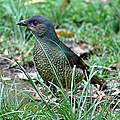Satin bowerbird
| Satin Bowerbird | |
|---|---|

| |
| Male | |

| |
| Female | |
| Scientific classification | |
| Kingdom: | |
| Phylum: | |
| Class: | |
| Order: | |
| Family: | |
| Genus: | Ptilonorhynchus Kuhl, 1820
|
| Species: | P. violaceus
|
| Binomial name | |
| Ptilonorhynchus violaceus (Vieillot, 1816)
| |
The Satin Bowerbird, Ptilonorhynchus violaceus is a bowerbird common in rainforest and tall wet sclerophyll forest in eastern Australia from southern Queensland to Victoria. There is also an isolated population in the Wet Tropics of north Queensland.
Like all bowerbirds, the Satin Bowerbird shows highly complex courtship behaviour. Mate choice in Satin Bowerbirds has been studied in detail by a group of researchers at the University of Maryland, College Park. Males build specialized stick structures, called bowers, which they decorate with blue, yellow, and shiny objects if these are available, including berries, flowers, and even ballpoint pens, drinking straws and other discarded plastic items. As the males mature they use more blue objects than other colours. Females visit these and choose which male they will allow to mate with them. In addition to building their bowers, males carry out intense behavioural displays called dances to woo their mates, but these can be treated as threat displays by the females. Nestbuilding and incubation are carried out by the females alone. Recent research has shown that female mate choice takes place in three stages:
- Visits to the bowers, before nests have been built, while the males are absent
- Visits to the bowers, before nests have been built, while the males are present and displaying
- Visits to a selection of the bowers, after nests have been built, leading to copulation with (typically) a single male.
Experimental manipulations of the ornaments around the bowers have shown that the choices of young females (those in their first or second year of breeding) are mainly influenced by the appearance of the bowers, and hence by the first stage of this process. Older females, which are less affected by the threatening aspect of the males' displays, make their choices more on the basis of the males' dancing displays. It has been hypothesized that as males mature their colour discrimination develops and they are able to select more blue objects for the bower.
It is not yet known whether this description would also hold good for other species of bowerbird. Males are uniformly coloured in a deep shiny blue.
Females might be mistaken for the Green Catbird or Spotted Catbird with distinctively green/brown or otherwise entirely brown upper body and lighter under body, but with very striking lilac eyes.
A rare natural intergeneric hybrid between the Satin Bowerbird and the Regent Bowerbird is known as Rawnsley's Bowerbird.
Gallery
-
Bower
-
Female
-
Female
-
Male
-
a male and his bower
-
a range of plastic artifacts in a bower
References
- Template:IUCN2006 Database entry includes justification for why this species is of least concern
- HANZAB Volume 7
- Coleman, S. W., Patricelli, G. L., & Borgia, G. (2004). Variable female preferences drive complex male displays. Nature, 428, 742-745.
External links
- BirdLife Species Factsheet
- Satin Bowerbird videos, photos & sounds on the Internet Bird Collection
- Bowerbirds: Nature, Art & History by Clifford B. Frith, Dawn W. Frith







